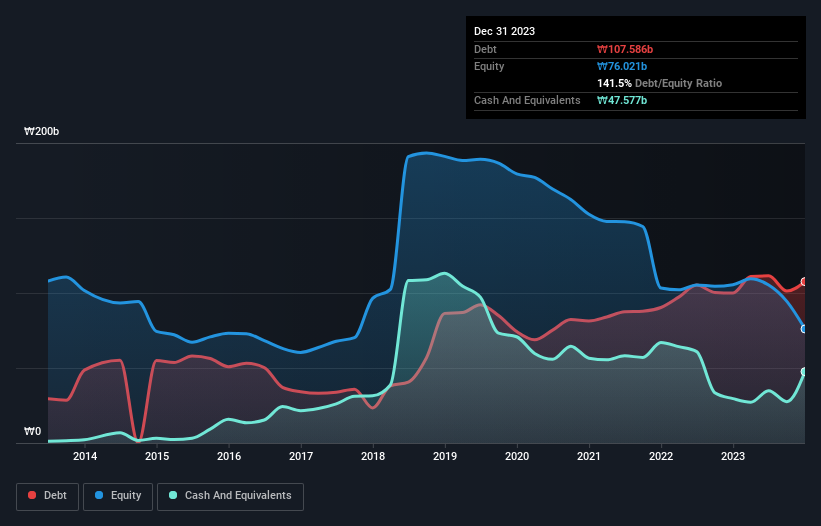Stock Analysis
- South Korea
- /
- Communications
- /
- KOSDAQ:A010170
Is Taihan Fiber Optics (KOSDAQ:010170) Using Too Much Debt?

Legendary fund manager Li Lu (who Charlie Munger backed) once said, 'The biggest investment risk is not the volatility of prices, but whether you will suffer a permanent loss of capital.' It's only natural to consider a company's balance sheet when you examine how risky it is, since debt is often involved when a business collapses. Importantly, Taihan Fiber Optics Co., Ltd (KOSDAQ:010170) does carry debt. But the real question is whether this debt is making the company risky.
When Is Debt A Problem?
Debt assists a business until the business has trouble paying it off, either with new capital or with free cash flow. In the worst case scenario, a company can go bankrupt if it cannot pay its creditors. While that is not too common, we often do see indebted companies permanently diluting shareholders because lenders force them to raise capital at a distressed price. Of course, debt can be an important tool in businesses, particularly capital heavy businesses. When we examine debt levels, we first consider both cash and debt levels, together.
See our latest analysis for Taihan Fiber Optics
What Is Taihan Fiber Optics's Net Debt?
As you can see below, at the end of December 2023, Taihan Fiber Optics had ₩107.6b of debt, up from ₩100.0b a year ago. Click the image for more detail. On the flip side, it has ₩47.6b in cash leading to net debt of about ₩60.0b.

How Healthy Is Taihan Fiber Optics' Balance Sheet?
The latest balance sheet data shows that Taihan Fiber Optics had liabilities of ₩138.5b due within a year, and liabilities of ₩20.2b falling due after that. Offsetting this, it had ₩47.6b in cash and ₩33.3b in receivables that were due within 12 months. So it has liabilities totalling ₩77.9b more than its cash and near-term receivables, combined.
This deficit is considerable relative to its market capitalization of ₩90.2b, so it does suggest shareholders should keep an eye on Taihan Fiber Optics' use of debt. This suggests shareholders would be heavily diluted if the company needed to shore up its balance sheet in a hurry. There's no doubt that we learn most about debt from the balance sheet. But it is Taihan Fiber Optics's earnings that will influence how the balance sheet holds up in the future. So if you're keen to discover more about its earnings, it might be worth checking out this graph of its long term earnings trend.
Over 12 months, Taihan Fiber Optics made a loss at the EBIT level, and saw its revenue drop to ₩180b, which is a fall of 5.2%. That's not what we would hope to see.
Caveat Emptor
Importantly, Taihan Fiber Optics had an earnings before interest and tax (EBIT) loss over the last year. Indeed, it lost a very considerable ₩23b at the EBIT level. When we look at that and recall the liabilities on its balance sheet, relative to cash, it seems unwise to us for the company to have any debt. So we think its balance sheet is a little strained, though not beyond repair. However, it doesn't help that it burned through ₩2.1b of cash over the last year. So suffice it to say we do consider the stock to be risky. When analysing debt levels, the balance sheet is the obvious place to start. But ultimately, every company can contain risks that exist outside of the balance sheet. We've identified 2 warning signs with Taihan Fiber Optics (at least 1 which is a bit concerning) , and understanding them should be part of your investment process.
When all is said and done, sometimes its easier to focus on companies that don't even need debt. Readers can access a list of growth stocks with zero net debt 100% free, right now.
Valuation is complex, but we're helping make it simple.
Find out whether Taihan Fiber Optics is potentially over or undervalued by checking out our comprehensive analysis, which includes fair value estimates, risks and warnings, dividends, insider transactions and financial health.
View the Free AnalysisHave feedback on this article? Concerned about the content? Get in touch with us directly. Alternatively, email editorial-team (at) simplywallst.com.
This article by Simply Wall St is general in nature. We provide commentary based on historical data and analyst forecasts only using an unbiased methodology and our articles are not intended to be financial advice. It does not constitute a recommendation to buy or sell any stock, and does not take account of your objectives, or your financial situation. We aim to bring you long-term focused analysis driven by fundamental data. Note that our analysis may not factor in the latest price-sensitive company announcements or qualitative material. Simply Wall St has no position in any stocks mentioned.

Simply Wall St
About KOSDAQ:A010170
Taihan Fiber Optics
Taihan Fiber Optics Co., Ltd researches, develops, and produces optical materials in South Korea and internationally.
Mediocre balance sheet and slightly overvalued.
